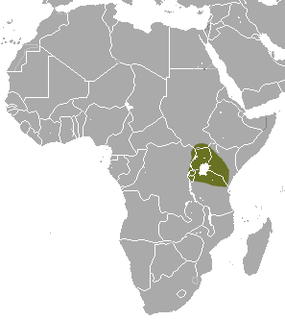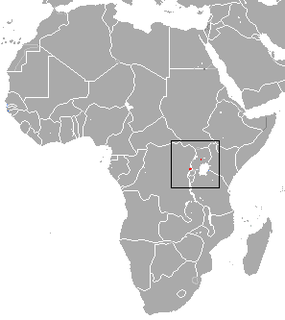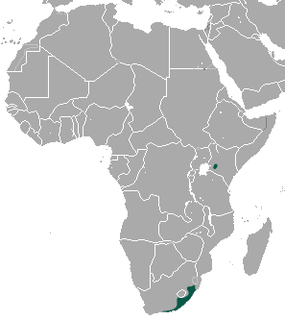
Tropical and subtropical moist forest (TSMF), also known as tropical moist forest, is a tropical and subtropical forest habitat type defined by the World Wide Fund for Nature. The habitat type is sometimes known as jungle.

Moloney's mimic bat is a species of vesper bat. It can be found in Angola, Cameroon, Central African Republic, Republic of the Congo, Democratic Republic of the Congo, Ivory Coast, Equatorial Guinea, Ethiopia, Gabon, Ghana, Guinea, Kenya, Liberia, Mozambique, Nigeria, Sierra Leone, South Sudan, Tanzania, Togo, Uganda, and Zambia. It is found in subtropical or tropical dry or moist forests, subtropical or tropical mangrove forests, subtropical or tropical moist montane forests, dry and moist savanna.
The broad-headed pipistrelle is a species of vesper bat in the family Vespertilionidae. It is found in Angola, Cameroon, Republic of the Congo, Democratic Republic of the Congo, Ivory Coast, Guinea, liberia, Kenya, South Sudan, and Uganda. Its natural habitats are subtropical or tropical dry forest, subtropical or tropical moist lowland forest, and subtropical or tropical moist montane forest.
Eisentraut's pipistrelle is a species of vesper bat in the family Vespertilionidae. It is found in Cameroon, Democratic Republic of the Congo, Kenya, Somalia, and Uganda. Its natural habitats are subtropical or tropical dry forest, subtropical or tropical moist lowland forest, subtropical or tropical mangrove forest, and subtropical or tropical moist montane forest.
The yellow serotine is a species of vesper bat.
The white-winged serotine is a species of vesper bat.

The singing quail is a species of bird in the family Odontophoridae. It is found in Belize, El Salvador, Guatemala, Honduras, and Mexico. Its natural habitats are subtropical or tropical dry forest, subtropical or tropical moist lowland forest, and subtropical or tropical moist montane forest.

The Mascarene grass frog, or Mascarene ridged frog, is a species of frog in the family Ptychadenidae. It is found in sub-Saharan Africa, Madagascar, and Mauritius.

The greater hedgehog tenrec, also known as the large Madagascar hedgehog or sokina, is a species of mammal in the family Tenrecidae. It is endemic to Madagascar. Its natural habitats are subtropical or tropical dry forest, subtropical or tropical moist lowland forest, subtropical or tropical moist montane forest, dry savanna, moist savanna, subtropical or tropical dry shrubland, subtropical or tropical moist shrubland, subtropical or tropical high-altitude shrubland, subtropical or tropical dry lowland grassland, subtropical or tropical high-altitude grassland, rural gardens, urban areas and zoos.

The Hun shrew is a species of mammal in the family Soricidae. It is found in Cameroon, Central African Republic, Mali, Democratic Republic of the Congo, and Nigeria. Its natural habitats are subtropical or tropical moist lowland forest, subtropical or tropical moist montane forest, and heavily degraded former forest.

Jackson's shrew is a species of mammal in the family Soricidae. It is found in Burundi, Democratic Republic of the Congo, Kenya, Rwanda, South Sudan, and Uganda. Its natural habitats are subtropical or tropical moist lowland forest, subtropical or tropical moist montane forest, and heavily degraded former forest.

The tarella shrew is a species of mammal in the family Soricidae. It is found in Democratic Republic of the Congo and Uganda. Its natural habitats are subtropical or tropical moist lowland forest and subtropical or tropical moist montane forest. It is threatened by habitat loss.

The least dwarf shrew is a species of mammal in the family Soricidae. It is found in Cameroon, Central African Republic, Democratic Republic of the Congo, Kenya, Nigeria, South Africa, Eswatini, Tanzania, and Uganda. Its natural habitats are subtropical or tropical moist lowland forest, subtropical or tropical moist montane forest, temperate grassland, subtropical or tropical dry lowland grassland, subtropical or tropical high-altitude grassland, and arable land.

The climbing shrew is a species of mammal in the family Soricidae, which is found in subtropical Africa. It is found in Angola, Benin, Burundi, Cameroon, Central African Republic, Republic of the Congo, Democratic Republic of the Congo, Ivory Coast, Ethiopia, Ghana, Guinea, Kenya, Liberia, Malawi, Mozambique, Nigeria, Rwanda, Sierra Leone, South Sudan, Tanzania, Togo, Uganda, Zambia, and Zimbabwe. Its natural habitats are subtropical or tropical moist lowland forest, subtropical or tropical moist montane forest, and moist savanna.

Nectandra is a genus of plant in the family Lauraceae found in South America, and having fruit with various medical effects. Sweetwood is a common name for some plants in this genus.
Nectandra canaliculata is a species of plant in the family Lauraceae. It is endemic to Ecuador. Its natural habitat is subtropical or tropical moist lowland forests.
Nectandra cerifolia is a species of plant in the family Lauraceae. It is endemic to Ecuador. Its natural habitat is subtropical or tropical moist montane forests.
Nectandra coeloclada is a species of plant in the family Lauraceae. It is endemic to Ecuador. Its natural habitats are subtropical or tropical moist lowland forests and subtropical or tropical moist montane forests.
Nectandra fragrans is a species of plant in the family Lauraceae. It is endemic to Ecuador. Its natural habitat is subtropical or tropical moist montane forests.
Acraga flava is a moth of the family Dalceridae. It is found in southern Brazil and northern Argentina. The habitat consists of tropical premontane moist, subtropical wet, subtropical moist, subtropical lower montane wet, subtropical lower montane moist and warm temperate moist forests.











